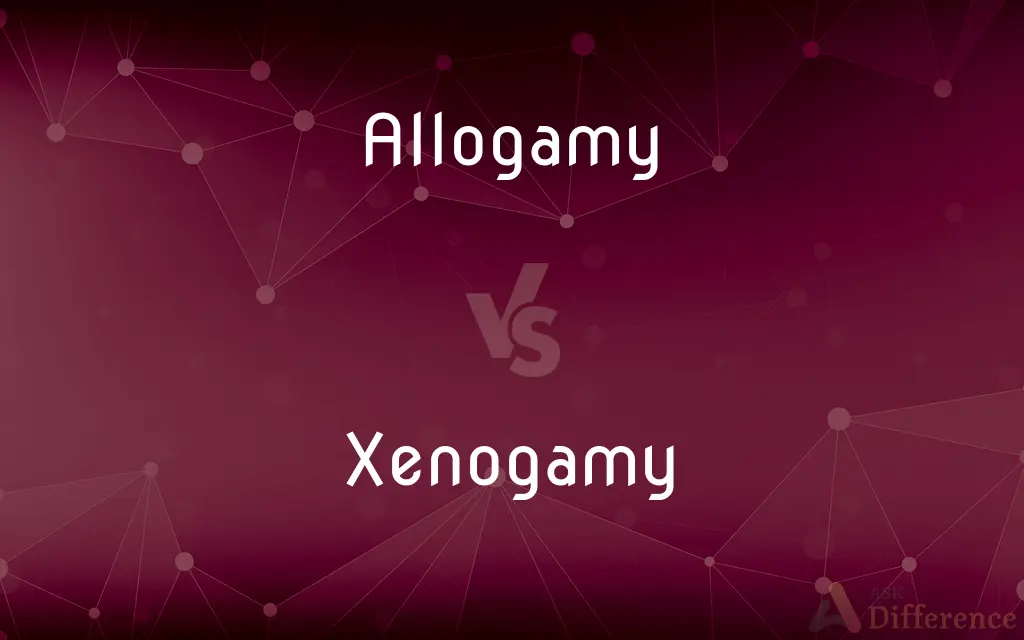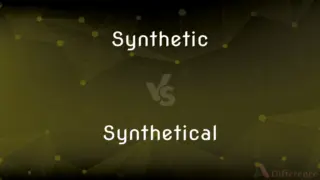Allogamy vs. Xenogamy — What's the Difference?
By Tayyaba Rehman — Updated on September 23, 2023
Allogamy refers to cross-fertilization between different flowers, while Xenogamy is a specific type of Allogamy involving pollen transfer between flowers of different plants.

Difference Between Allogamy and Xenogamy
Table of Contents
ADVERTISEMENT
Key Differences
Allogamy and Xenogamy both delve into the realm of plant reproduction, yet they are not synonymous. Allogamy, in a broad sense, signifies the transfer of pollen from the anther of one flower to the stigma of another flower, allowing cross-fertilization to occur. Xenogamy, on the other hand, is a more specific process where this cross-fertilization happens between flowers from different individual plants.
When discussing Allogamy, one is referring to a general mode of plant reproduction that emphasizes genetic diversity. It involves any scenario where pollen is transferred between separate flowers. Xenogamy, meanwhile, ensures this diversity by ensuring that the pollen is not just transferred to another flower, but to a flower on an entirely different plant.
It's crucial to grasp that while all Xenogamy is Allogamy, not all Allogamy is Xenogamy. Allogamy could involve cross-fertilization between flowers of the same plant, which wouldn't be Xenogamy. But Xenogamy always involves pollen movement between distinct plants, making it a subset of Allogamy.
The implications of both processes are profound in the world of botany. Allogamy, by promoting cross-fertilization, encourages genetic variability, which can lead to more robust plant populations. Xenogamy takes this a step further by ensuring that this genetic material is mixed between entirely separate plants, thereby enhancing the genetic pool even more.
Comparison Chart
Definition
Cross-fertilization between different flowers
Cross-fertilization between flowers of different plants
ADVERTISEMENT
Genetic Diversity
Promotes genetic variability
Enhances genetic pool between separate plants
Scope
Broader scope of cross-fertilization
Subset of Allogamy
Pollination Scenario
Between separate flowers, possibly on the same plant
Always between flowers on different plants
Resulting Genetic Exchange
Potential for intra-plant or inter-plant genetic exchange
Strictly inter-plant genetic exchange
Compare with Definitions
Allogamy
Cross-fertilization between different flowers.
Allogamy helps in the promotion of genetic diversity in plant populations.
Xenogamy
A specific form of Allogamy involving different plants.
While Allogamy can be intra-plant, Xenogamy always involves separate plants.
Allogamy
Pollination involving separate flowers.
The movement of pollen from one flower to another is a classic example of Allogamy.
Xenogamy
An evolved mechanism to avoid inbreeding in plants.
To prevent inbreeding, many plants have evolved to favor Xenogamy.
Allogamy
A broad form of non-self fertilization.
Allogamy can occur even between flowers of the same plant.
Xenogamy
Inter-plant pollen transfer for fertilization.
The bee transferred pollen between two plants, facilitating Xenogamy.
Allogamy
A reproductive strategy promoting variability.
Many plants have evolved mechanisms to promote Allogamy.
Xenogamy
Cross-fertilization between flowers of different plants.
Xenogamy is a mechanism ensuring genetic material exchange between separate plants.
Allogamy
Opposite of autogamy where a plant fertilizes itself.
While autogamy involves self-fertilization, Allogamy ensures cross-fertilization.
Xenogamy
Ensures broader genetic diversity in plant populations.
Through Xenogamy, plants can share genetic traits with other distinct plant individuals.
Allogamy
Allogamy or cross-fertilization is the fertilization of an ovum from one individual with the spermatozoa of another. By contrast, autogamy is the term used for self-fertilization.
Xenogamy
Xenogamy (Greek xenos=stranger, gamos=marriage) is the transfer of pollen grains from the anther to the stigma of a different plant. This is the only type of cross pollination which during pollination brings genetically different types of pollen grains to the stigma.The term xenogamy (along with geitonogamy and autogamy) was first suggested by Kerner in 1876.
Allogamy
See cross-fertilization.
Xenogamy
See cross-pollination.
Allogamy
See cross-pollination.
Xenogamy
(botany) The transfer of pollen from the anthers of one plant to the stigma of another; cross-pollination
Allogamy
(biology) The fertilization of an ovum from one individual with the spermatozoa of another; cross-fertilization
Xenogamy
Cross-cultural marriage
Allogamy
Fertilization of the pistil of a plant by pollen from another of the same species; cross-fertilization.
Xenogamy
Cross fertilization.
Allogamy
Cross-fertilization in plants
Common Curiosities
Why is Xenogamy significant?
It ensures broader genetic diversity by mixing genetic material between separate plants.
How is Xenogamy different from Allogamy?
Xenogamy is a specific type of Allogamy involving flowers from different plants.
Is Xenogamy a form of Allogamy?
Yes, Xenogamy is a subset of Allogamy.
Does Allogamy always involve different plants?
No, Allogamy can occur between flowers of the same or different plants.
Does Xenogamy promote genetic variability?
Absolutely, by ensuring cross-fertilization between distinct plants.
How do plants ensure Xenogamy?
Many have evolved mechanisms like differing bloom times or specialized pollinators.
Can Allogamy occur on the same plant?
Yes, if pollen transfers between separate flowers of the same plant.
Are there mechanisms that prevent Allogamy?
Some plants have mechanisms promoting self-fertilization, thus limiting Allogamy.
What does Allogamy mean?
Allogamy refers to cross-fertilization between different flowers.
Which process ensures a more diverse genetic pool: Allogamy or Xenogamy?
While both promote diversity, Xenogamy ensures a broader genetic mix by involving distinct plants.
Is Allogamy the opposite of self-fertilization?
Yes, while autogamy is self-fertilization, Allogamy involves different flowers.
Can Xenogamy occur between flowers of the same plant?
No, Xenogamy always involves flowers from different plants.
Why do plants engage in Allogamy?
Allogamy promotes genetic diversity, leading to stronger plant populations.
Is Xenogamy a natural mechanism against inbreeding?
Yes, by ensuring genetic exchange between different plants.
What role do pollinators play in Allogamy and Xenogamy?
They transfer pollen between flowers, facilitating both Allogamy and Xenogamy.
Share Your Discovery

Previous Comparison
Synthetic vs. Synthetical
Next Comparison
Justification vs. SanctificationAuthor Spotlight
Written by
Tayyaba RehmanTayyaba Rehman is a distinguished writer, currently serving as a primary contributor to askdifference.com. As a researcher in semantics and etymology, Tayyaba's passion for the complexity of languages and their distinctions has found a perfect home on the platform. Tayyaba delves into the intricacies of language, distinguishing between commonly confused words and phrases, thereby providing clarity for readers worldwide.














































